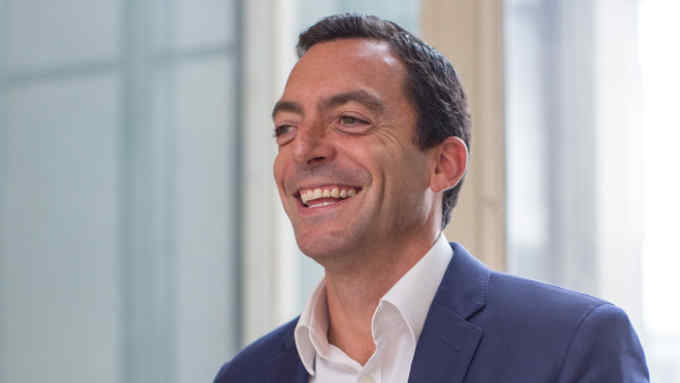Hazy 5G growth agenda nags telecom chiefs

Roula Khalaf, Editor of the FT, selects her favourite stories in this weekly newsletter.
Mobile phone users in the Finnish city of Tampere and the Estonian capital Tallinn were the first in the world to be connected to a commercial 5G network in June when Elisa, the Finnish mobile phone company, switched on the first live next-generation service and made a video call between the two cities.
Finland has a long history as a pioneer of wireless technology so it was little surprise that an operator from the Nordic country had beaten its global rivals to the punch by offering 5G packages for €50 a month. There was just one catch — there are no 5G smartphones available on the market and there will not be until midway through 2019. Elisa is in effect selling something called 5G that will deliver a 4G service.
Kester Mann, an analyst with CCS Insight, a consultancy, says: “This is a muddled and confusing message for customers and one that is potentially damaging to an industry that has had its fingers burnt in the past by setting unrealistic expectations.”
Global telecoms companies are racing to be the first to “launch” 5G — whether in Europe, where the microstate San Marino has boasted of having the first nationwide network; or in Asia, where a 5G service was trialled during the Winter Olympic Games in South Korea. In the Middle East, four separate networks all revealed grandiose 5G plans within days of each other. Mr Mann says it was “more akin to a playground squabble than a technology breakthrough”.
That was also evident in the US where the industry has turned on itself. AT&T, the US network, was the first to tap into the groundswell for faster speeds when last year it launched a 4G tariff called 5G Evolution, which its rivals labelled “#Fake5G”.
Neville Ray, T-Mobile’s chief technology officer, says that the “5G hype machine is already in overdrive” and dismisses attempts by his larger rivals to grab attention with 5G marketing. “‘Look over here!’ is not a strategy for delivering on real network transformation. It does a disservice to customers, the industry and to the technology itself — because 5G is truly transformational,” he says.
To hammer home the point, T-Mobile in July signed a $3.5bn equipment deal — the largest to date — with supplier Nokia to roll out its new network. “We are all in on 5G,” said Mr Ray at the time. “Every dollar we spend is a 5G dollar.”
The company will battle against Verizon and AT&T for 5G supremacy. Verizon appointed Hans Vestberg, the Swede who ran Ericsson previously, as chief executive, putting the network upgrade in the hands of a 5G specialist.
It remains to be seen how telecoms companies will sell 5G to consumers when handsets that can connect to the new networks come on to the market. Motorola, Huawei, Sony, Samsung and Apple are expected to be among the first to unveil 5G phones from next year. The faster speeds and greater efficiency will appeal to heavy data users that want to stream high-definition video or play video games online. In the future it could open the door to new forms of communication, including holograms, that could have a huge impact on video calling and conferencing.
Yet the real advantages could be for businesses and growth in gross domestic product if those companies can take advantage of the faster, more efficient networks. An O2 report published this year estimated that 5G could generate £6bn of savings a year for British businesses, through reduced road congestion and rail delays as cities become smarter, as well as the impact of better electricity and healthcare technology.
Philip Marnick, spectrum director at British regulator Ofcom, says the most exciting element of 5G services is the prospect for the development of “internet of things” and new applications including wireless factories. “5G provides an opportunity for other types of industry to use it to develop their own high-capacity services,” he says.
Operators themselves could benefit, given they face an inexorable rise in the amount of data passing over their networks yet struggle to charge more for it. The technologies that underpin 5G can be used to radically cut the cost of carrying the data. Fredrik Jejdling, Ericsson’s head of business area networks, says that the main advantage for networks investing in 5G is one of cost. “If customer traffic grows eight times, we can’t charge them eight times more. We need to drive that cost down,” he says.
That is a key message for investors, particularly in Europe, that have struggled to see the benefit of bankrolling billions of dollars of investment in 5G networks without a visible growth agenda for the struggling telecoms sector. Reducing costs to improve profitability could be critical to getting investors on side. Ericsson expects there will be 3.5bn “internet of things” connections using 5G by 2023, and 1bn consumers on the faster networks globally, representing 12 per cent of mobile subscriptions.
Yet 5G is not a slam dunk for telecoms companies. A recent survey conducted by consultancy Bain found that of the 19 largest global mobile phone companies, just over half said they saw no near-term business case for the technology.
“When it comes to 5G, many telecom executives seem to have lost their faith in the power of technology to deliver more,” said Herbert Blum, who authored the report.
5G may not be an overnight sensation but it is set to grow rapidly in the countries where networks place an early bet on the new technology — as long as expectations are kept in check.

Comments